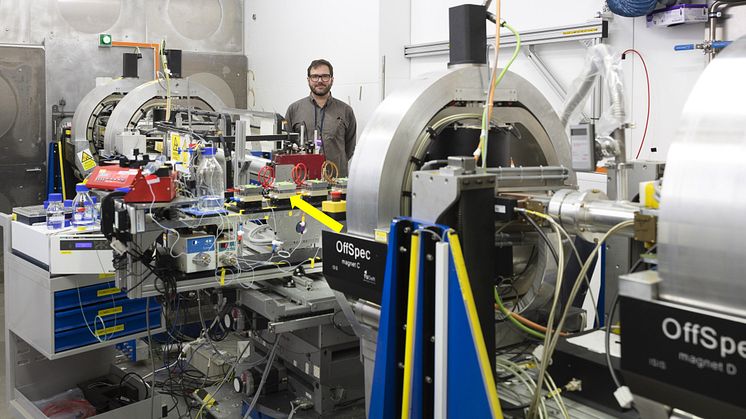
Press release -
Neutrons provide unique insight into programmed cell death
Using neutron reflectometry, researchers at the Department of Chemistry, Umeå University, provide new atomic-level understanding of how Bax, a protein that helps remove damaged cells in the body, works. The results of the study, conducted in collaboration with the ESS research facilities in Lund and ISIS in the UK, are published in the journal Science Advances.
"This work is relevant for understanding basic cellular processes and the biological process behind cancer" says Gerhard Gröbner, Professor at the Department of Chemistry, Umeå University. ”It also demonstrates the usefulness of neutron reflectometry. The method generates unique information at the molecular level in biophysical and biomedical research and opens up the understanding of the relationship between aging and cancer.”
Programmed cell death involves the controlled removal of harmful and superfluous cells in the body. The process is fundamental to keeping us healthy. Therefore, programmed cell death is tightly regulated by a family of key proteins called the Bcl-2 family, which includes the cell-killing protein Bax. These proteins have opposing functions, some are cell-protective while others are cell-killing. A healthy cell has a balanced equilibrium between the different Bcl-2 proteins. However, an imbalance between these proteins during programmed cell death can interfere with the development of the embryo during the fetal stage, and can also lead to various diseases, mainly cancer.
'However, cancer cells are able to protect themselves against the effect of the cell-killing protein Bax, which is generally a problem in cancer treatment” says Gerhard Gröbner and his colleague Jörgen Ådén.
To remove harmful cells, the body activates cell-killing proteins such as Bax. Activated Bax perforates the outer membrane part of the mitochondria (the cell's powerhouse), causing the cell to die. Unfortunately, elevated levels of the cell-protecting membrane protein Bcl-2 block the action of the Bax protein. This is a major cause of growth and treatment resistance in many tumors.
”Developing a molecular understanding of how Bax attacks mitochondria may therefore open the way for the development of, for example, Bax-optimized anti-cancer drugs" says Gerhard Gröbner.
However, how the cell-killing Bax protein binds to mitochondrial membrane surfaces and performs its function is poorly understood, as detailed images and structures of the membrane were previously unavailable.
In the current study, the researchers mainly used the neutron reflectometry (NR) technique together with an advanced instrument at the ISIS neutron facility in England, in close collaboration with the ESS in Lund, which is currently under construction.
They studied the structure of Bax in different membrane environments and with time-resolved experiments they were able to see how Bax forms pores in the membrane. This provided a molecular and mechanistic insight into this critical process during cell death.
Key collaborators have been Dr. Luke Clifton at ISIS and Dr. Hanna Wacklin-Knecht, ESS, and the Department of Physical Chemistry at Lund University. The collaboration was made possible thanks to the Swedish Research Council's specially targeted project grant. The project is a good example of how neutrons can be used in groundbreaking research and also prepares other research groups in how the technology can be used.
”In future experimental studies, we hope to find out how overproduction of the cell-protecting Bcl-2 protein and cell-killing Bax interact in membranes to understand the mechanism of how tumor cells avoid programmed cell death" says Gerhard Gröbner.
About the scientific study:
Luke Clifton, Hanna P. Wacklin-Knecht, Jörgen Ådén, Ameeq Ul Mushtaq, Tobias Sparrman, Gerhard Gröbner, Creation of distinctive Bax-lipid complexes at mitochondrial membrane surfaces drives pore information to initiate apoptosis, Science Advances, DOI 10.1126/sciadv.adg7940
http://www.science.org/doi/10.1126/sciadv.adg7940
For more information, please contact:
Gerhard Gröbner, Professor, Department of Chemistry, Umeå University
Phone: +46 73 097 32 56
E-mail: Gerhard.grobner@umu.se
Topics
Categories
Umeå University
Umeå University is one of Sweden’s largest institutions of higher education with over 37,000 students and 4,300 faculty and staff. The university is home to a wide range of high-quality education programmes and world-class research in a number of fields. Umeå University was also where the revolutionary gene-editing tool CRISPR-Cas9 was discovered that has been awarded the Nobel Prize in Chemistry.
At Umeå University, distances are short. The university's unified campus encourages academic meetings, an exchange of ideas and interdisciplinary co-operation, and promotes a dynamic and open culture in which students and staff rejoice in the success of others.


